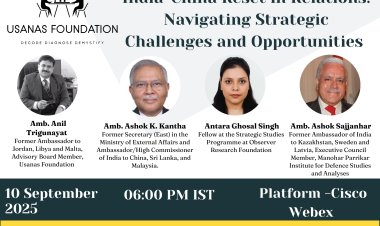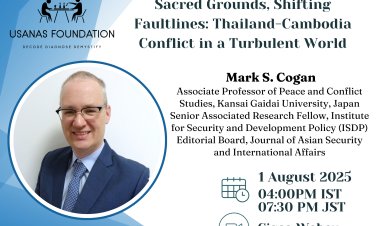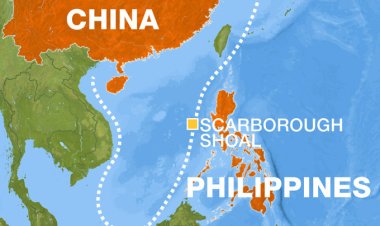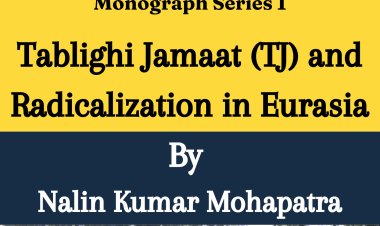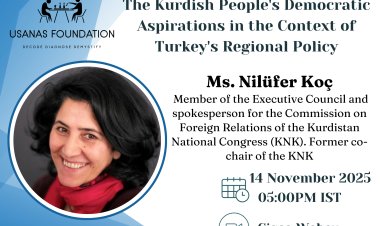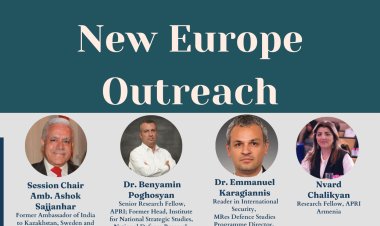The Belt and Road Initiative and the Chinese Strategic Thought: Machination of its Suzerainty
This article is a part of a three-article series that analyzes various aspects of the Belt and Road Initiative as it celebrates its 10th anniversary. The first article will provide the readers with an account of the origins, history, and strategic thought that guides China’s policies, including the BRI.
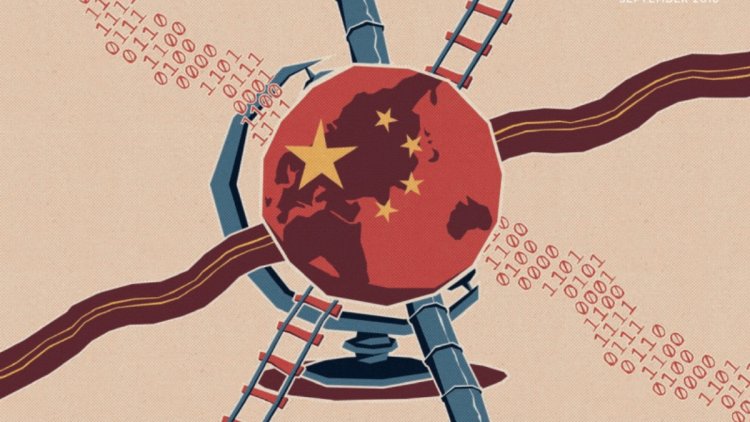
Analysis
By Shivani Pandey
This article is a part of a three-article series that analyzes various aspects of the Belt and Road Initiative as it celebrates its 10th anniversary. The first article will provide the readers with an account of the origins, history, and strategic thought that guides China’s policies, including the BRI. The second article will analyze the role of international law and organizations vis-à-vis the Belt and Road Initiative in the backdrop of Italy’s withdrawal and China’s ceasing future funding to the CPEC. The third article will discuss the impact of BRI on China’s domestic economy and on partner countries and the future troubles that surround the project.
About the Belt and Road Initiative
The Belt and Road Initiative (BRI), earlier termed as One Belt, One Road (OBOR) project is a series of infrastructural developments across the continental landmass and maritime spheres aimed to augment supply chain logistics and connectivity across Asia and Europe. Announced in 2013, soon after Chinese President Xi Jinping assumed office, it is his most ambitious and strategic foreign and economic policy, which he hailed as the “project of the century.” It promised to boost apart from trade linkages, cultural and knowledge linkages, employment, diminish poverty, confront challenges to mankind and usher modernization and common development. In 2017, the project was incorporated into the Constitution of the Chinese Communist Party (CCP), the only foreign policy decision accorded such status, making it a core principle of the party and rendering it impossible to forfeit.
The project is designed in two parts: the first is called the “Silk Road Economic Belt” and the second is called the “21st Century Maritime Silk Route.” The “belt” refers to overland continental trading routes building factories, bridges, roads, airports, power grids and telecommunication networks in the hinterlands of the Eurasian heartland. The entire project consists of 6 principal economic corridors: the China-Mongolia-Russia Economic Corridor, the New Eurasian Land Bridge, the China-Central Asia-West Asia Economic Corridor, the China-Indochina Peninsula Economic Corridor, the China-Pakistan Economic Corridor and the Bangladesh-China-India-Myanmar Economic Corridor.
The “road” is a maritime route building ports, fuelling stations, and energy pipelines, connecting Quanzhou, Guangzhou, Beihai, and Haikou in China to Jakarta in Indonesia, Kuala Lumpur in Malaysia, Colombo in Sri Lanka, Nairobi in Kenya, the port of Djibouti, Athens in Greece, Venice in Italy, and Rotterdam in Netherlands.
Current Status
Given the quantum of investment, the transformation it seeks and the unfolding consequences, the BRI is often paralleled with the Marshall Plan (US’ economic aid to reconstruct war-torn European nations), or as a Faustian Pact (deal with the devil; a bargain in which countries trade-off national security for cheap loans), or as China’s third revolution (following Mao’s cultural revolution and Deng’s economic revolution).
Today, the BRI includes within its ambit 152 countries and 32 international organizations. At the end of June 2023, China has signed over 200 cooperation documents with partner countries, it is the largest trading partner of 25 countries, signed free-trade agreements with 7 countries and established bilateral e-commerce cooperation mechanisms with 29 countries, created over 400,000 jobs and helped 40 million people out of poverty. It is the fastest-growing global collaboration that is redesigning the world map on a real-time basis and a movement that is impacting the totality of human existence, directly or indirectly.
Historical Genesis
The BRI is touted as a project that will reinvigorate trade as that existed along the ancient Silk Road, with China at the centre. The ancient Silk Road was an intricate trade network believed to have developed under the Chinese Han Dynasty that ruled the Middle Kingdom around (206 BCE to 220 CE) when a royal emissary of the court, Zhang Qian traveled westward. Later during the dynasties of Song and Yuan, these routes further developed and trade over it boomed. In the 15th century, under the Ming Dynasty, Zhang He undertook voyages across Asia and Africa. These historical events are often cited by the Chinese leadership to advocate its emissaries, BRI, and its foreign policy at large, as harbingers of peace and cooperation, unlike the Western aggressors who arrived to conquer using warships, guns, or swords.
However, these claims remain contested. There has been disagreement over the veracity of the Chinese empire being the center of this ancient silk route, as often claimed. According to Shyam Saran, the Silk Road was a “network of caravan routes that connected countries,” connecting China, Central Asia, India, Persia, the Arab lands, and the Mediterranean. Contradicting Chinese centrality, he states that “China was at the periphery and nowhere a nodal point” of the silk route. Further, according to Robert Kaplan, the silk route “largely flourished under the Mongols,” and for Bertil Litner “no southern silk route ever existed.” While the past may be contested, the present cannot and the Belt and Road Initiative is the reality that we must grapple with. With its incorporation into the Constitution, it is highly unlikely that a troubled domestic economy or domino of debt traps will waver the CCP’s quest to accomplish its vision through this project. But this begs the question, what is its vision?
China’s Strategic Thought
After the launch of the ambitious BRI project, scholars across the spectrum have attempted to analyse, and predict the ultimate ambition of this project. They have strived to read between the lines, moving beyond the official state stance of peaceful co-development. Jonathan Hillman correctly observed that the “Belt and Road is so big it is almost impossible for one person to have mastery of it.”
But as the project completes ten years, an insight into some of China’s key strategic thoughts can perhaps give some understanding of the whys and whats of the BRI: Why is China undertaking this mammoth task and what it hopes to achieve? There are three main sources of Chinese strategic thought: Sun Tzu’s Art of War, Confucianism, and the Stratagems of the Warring States. Some of these are discussed below:
Taotai 淘汰 – This term represents the Chinese understanding of the Darwinian thought of evolution. It is how China perceives the five-fold racial classification. For them, there are two superior races, yellow and white. Further, as Micheal Pillsbury observes in his book, according to the Chinese, the weak race is always devoured by the stronger. The two superior races are engaged in a “merciless struggle for supremacy over the red, brown and black races.” This racial struggle between the yellow and white races, according to Taotai, will shape the future of mankind.
Wài rú nèi fǎ 外儒內法 – Interpreted differently as “benevolent on the outside, ruthless on the inside” or “Confucius on the outside, legalist on the inside,” this expression, according to Pillsbury, best summarizes the entirety of Chinese history. From its annexation of Tibet to its actions at Tiananmen Square or its repression of the Uyghur minorities, these actions are defended within and outside the country as benefitting the larger interest of the Chinese population and national integrity. Similarly, the Chinese leadership has conveniently overlooked the protests against its projects in BRI partner countries and instead hailed it as “people-centred” development that is “beneficial to all,” making BRI a vehicle for the promotion of benevolent authoritarian governance.
Bù zhàn qū rén 不戰屈人– A strategy advocated in Sun Tzu’s Art of War, it holds that the most supreme art of war is “subjugating the enemy without a war.” This strategy has been a recurrent theme in China’s tactical competition against its rivals. The use of state-sponsored disinformation in the digital space, the use of applications such as tik-tok, technology theft, economic dependency by monopolizing manufacturing, massive economic investments into foreign economies, or meddling in elections are all illustrations of Chinese tactics of weakening the enemy or the competitor without engaging in a conventional warfare.
Jiǔ Dǐng 九鼎 – In ancient China, Tripod Cauldrons were hosted at the royal courts as a symbol of power and authority to rule, given to the ruler by mandate of heaven. The Chinese strategists believe that a rising power should “never ask the weight of the ruler’s cauldrons,” implying that the hegemon or the enemy should not know that you are a rival until it is too late to stop you. The revisionist power can only succeed by concealing any ambitions of overthrowing the emperor, to avoid being destroyed by it. It is only when the hegemon becomes too weak that the rising power should reveal his true intentions.
Datong 大同 – Translated as “Global Harmony,” it is a Chinese ideal or a vision of utopian world that is harmonious, where “the world belongs to all…selfish schemes do not arise.” China’s leaders have repeated this vision of global unity at multiple international platforms, promoting “a world of great harmony” as their main aim. However, according to some scholars, the term datong is better translated to “an era of unipolar dominance.” They hold that the Chinese leadership’s support of a multipolar and harmonious world is a rhetoric as they stealth their way to global supremacy. This view is further buttressed by Confucius' thought “There cannot be two suns in the sky, nor there can be two emperors on earth.”
Tianxia 天下 – Used by Zhu Dynasty, roughly translating to “all under heaven,” the term denotes the Chinese version and vision of the world order. Derived from datong and the Confucian principles of hierarchy, it is a geographical, psychological, and institutional concept. It refers to a “tributary system” of world order in which China as a “superior civilization” is accorded the top spot and the core in a civilized world, followed by the loyal tributaries and barbarian wilderness at the peripheries. Further, as the center of this world, it is then the responsibility of the Chinese state to harmonize the world and propagate knowledge, values, and culture so that the rest of the world confirms to this (Chinese) order.
World After BRI
In On China, Henry Kissinger states that the Chinese strategy is guided by its game Wei Qi. Unlike in western chess in which players emphasize on finding the quickest way to defeat the opponent, Wei Qi is a long-drawn game, where players patiently build up their assets to tip the odds in their favor. Thus, wei qi, and the Chinese game in world politics, envision long-term strategic victories and not short-term gains. BRI is also a long-drawn game; launched in 2013, it is scheduled to be completed by 2049. This completion coincides with Xi’s ambition of National Rejuvenation, a plan to achieve “lasting greatness for the Chinese nation” through a “Chinese path to Modernisation” (Xi in 20th CPC Report). BRI is Xi’s Wei Qi against the Western-led order.
The academic scholarship continues to debate the plausibility of warfare between the US and China. According to Graham Allison, the two powers are engaged in a “Thucydides trap” making them “destined for war.” Similarly, Robert Kaplan also believes that the occurrence of this war is increasingly becoming more probable. However, on the contrary, Joseph Nye believes that the two countries are “not destined for war.” But, while the probability of conventional warfare continues to be speculated, there is a consensus that ideological warfare between the two powers has already begun.
The contest between the US and China is not just economic or military or controlling strategic territories and waters, it is at the core a war of thoughts and the way of life. In this war, BRI is the ultimate ammunition in Chinese artillery to promote its ideology, governance model, and its pathway to modernization. As this paper concludes, it is worth asking the question that one always ponders when they come across BRI. What will the world be like under Chinese leadership? What will a world under BRI look like? Bruno Maçães best describes this, in his book “Belt and Road: A Chinese World Order.” Following is an excerpt from it:
“Throughout mankind’s history cities have been hacked out of the jungle. In Forest City, the jungle and city co-exist…Sometimes a skyscraper (here) will be finished in as little as a week…Its inhabitants are all Chinese…Shop signs are written in Mandarin and restaurants serve food from Sichuan and Yunnan. But the city is built in Malaysia, not China…It is impossible to miss there are four separate strata in the city. First, the residents: wealthy Chinese from the mainland. Second, those providing professional services…Chinese or Europeans or Americans. Third, the guardians: Nepalese security guards. Fourth, the workers: Bangladeshi and Indians.”
This hierarchical view of the society in the Forest City, a city that is developed in Malaysia as part of the BRI project, is an appropriate metaphor to represent the hierarchical world order that will ensue under Chinese leadership. BRI is not limited to securing natural and critical resources or cushioning its surplus industries by rechannelling them through the BRI projects. It is not just acquisition of key strategic ports or trade routes. It is accepting Chinese supremacy, political, military, economic, and ideological. It is the creation of a new civilization. It is the creation of Tianxia.
Disclaimer: This paper is the author's individual scholastic contribution and does not necessarily reflect the organization's viewpoint.











